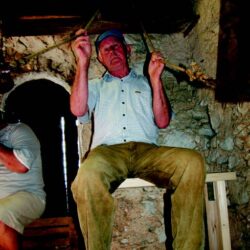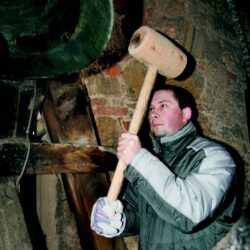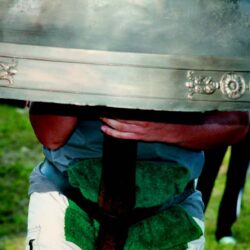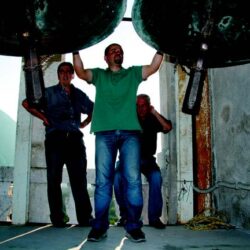Bell Chiming
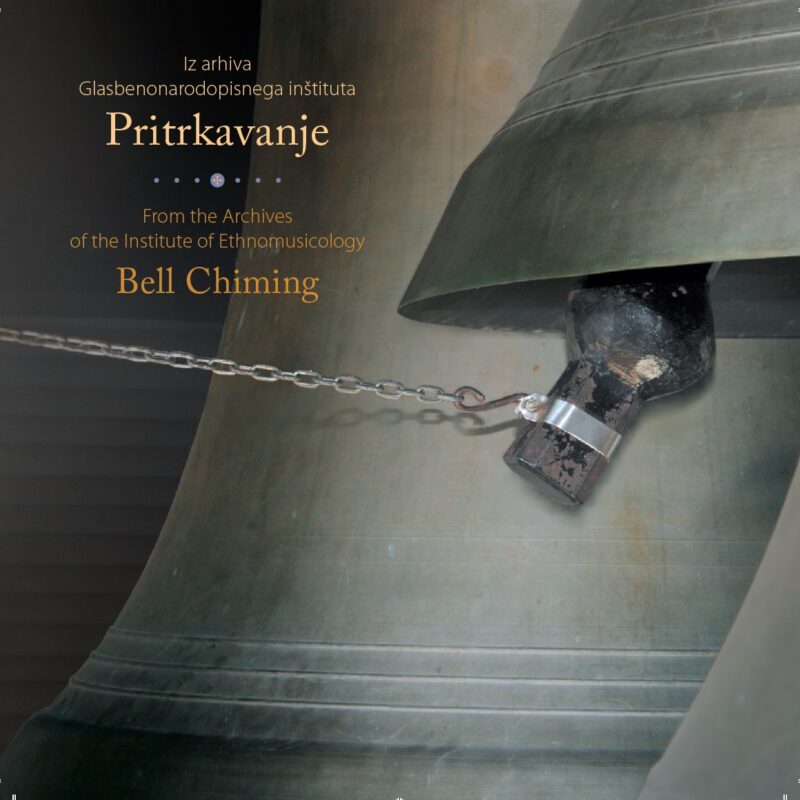
GNI Velike Češnjice, 8. 7. 2008, Dol./9
Recorded: Velike Češnjice, 2008
Chimer: Janez Bijec (1954) from Šentvid pri Stični
Bell chimers in Lower Carniola often used rapid repeating strikes against individual bells to announce the beginning of a bell-chiming performance. The recording shows how this was once done in Šentvid pri Stični. The introductory strikes, which became increasingly stronger, were immediately followed by a series of flying tunes. For major holidays, the introduction was longer.
GNI Brezje, 9. 9. 2007, Gor./21
Recorded: Brezje, 2007
Chimers: Roman Ažman (1963), Jaka Zadnikar (1936)
The flying tunes are most often performed in Upper Carniola and bell chimers describe them as having a merrier character; this is most likely due to the tempo and volume produced by a swinging bell. Chimers swing the bell, which is usually the largest, manually or using an electric motor. They do not pause between individual tunes of the swinging (or flying) bell, and they let the bell ring a few beats by itself while preparing to perform the next tune.
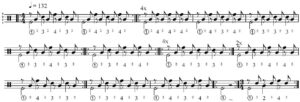
GNI Tolmin, 15. 8. 2007, Prim./7
Recorded: Tolmin, 2007
Chimers: Matej Hrast (1990), Tomo Orbanič (1991), Primož Toplikar (1988)
When enough chimers are available in a parish, each one usually performs on his own bell. Every chimer performs a specific role: main, response, or thickening strikes. They also exchange their roles and thus create more complex melodies, which is also evident from the title of this tune: the first and second bells take turns performing the response strikes, in which each performs two or four strikes in a bar.

GNI Brezje, 9. 9. 2007, Gor./5
Recorded: Brezje, 2007
Chimers: Janez Hočevar (1953), Janez Hočevar (1986), Jože Korene (1969) from Škocjan
If there are not enough bell chimers in a parish or if it is the local tradition, chimers play two or more bells at once. This gives them more freedom in shaping the rhythmic structure, which can also be heard in this recording in which the chimer improvises using two smaller bells. Before the tune, they play the introductory strikes on individual bells.
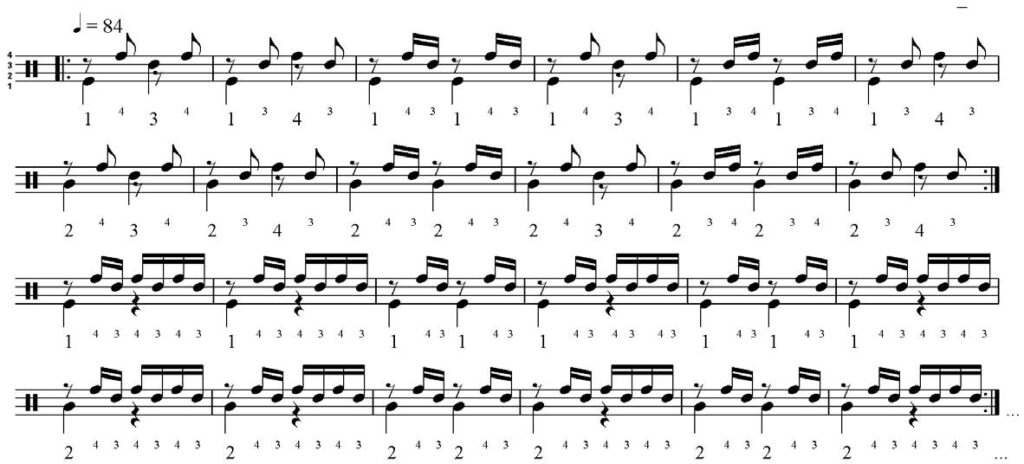
GNI Zasavska sveta gora, 8. 6. 2008, Štaj./6
Recorded: Holy Mount in the Central Sava Valley, 2008
Chimers: Bojan Baloh (1973), Blaž Križnar (1989), Peter Vidmar (1935) from Dob
There are not many bell towers in Slovenia with five bells and therefore the technique for chiming five bells is uncommon. In this recording three chimers perform on five bells. The main and response strikes are divided among three bells, whereas thickening strikes (which change randomly) are performed by one chimer using two bells.

GNI Velike Češnjice, 8. 7. 2008, Dol./6
Recorded: Velike Češnjice, 2008
Chimer: Ivan Hribar (1939)
The church in Velike Češnjice once had four bells, but they were confiscated during the First World War for military purposes. It later obtained three new bells, but retained the tradition of chiming four bells by hanging an additional clapper onto the second bell (strikes using an additional clapper or hammer are marked x in the notation). This strikes against a different place on the rim of the bell, thus producing a different sound. The chimer positions the levers such that he can chime four bells by himself. The tune Radetzky copies the introductory part of Johann Strauss Sr.’ Radetzky-Marsch.

GNI DAT 337/12
Recorded: Moste, 2005
Chimers: Tomaž Gašperlin (1981), Andrej Gašperlin (1949), Boštjan Koncilja (1985), Rok Zabret (1965)
Bronze bells are generally more highly valued than iron bells, but some bell chimers prefer the iron ones. The chimers in Moste claim they prefer the iron ones because they can substitute for certain tones by striking the iron hammer against them, whereas they would not be able to use hammers with bronze bells because they are too fragile.

GNI 12. 5. 2007, Kor./T33
Recorded: Vuhred, 2007
Chimers: Rok Plešivčnik (1983), Andrej Pšeničnik (1982); Libeliče
It is not common in bell chiming for several bells to chime at the same time, but the practice of simultaneous strikes can be observed in some places in Styria and Carinthia. This is connected with the how the sound is produced and is more frequently used when playing with hammers. In this recording two bell chimers from Libeliče play two bells using wooden hammers (in this case, the musical and numerical notations mark the relative pitch rather than the size of the bell because the bell chimers produce four different pitches using two bells).

GNI DAT 336/3
Recorded: Caresana (Italy), 2006
Chimers: Aljoša Novak (1978), Martin Tul (1982), Niko Tul (1971)
Younger bell chimers from Caresana learned how to chime at a bell-chiming course that the Trieste Association of Church Choirs held in various parishes in Italy. Today bell chimers regularly attend bell-chiming gatherings and other bell-chiming events in Slovenia and in Slovenian ethnic territory abroad, thus expanding their repertoires.

GNI DAT 336/7
Recorded: Caresana (Italy), 2006
Chimers: Danijel Novak (1953), Vladimir Novak (1949)
Older bell chimers from Caresana say they perform their tunes “the Istrian way”. This means that one chimer plays two bells, and the other performs the main strikes on the largest bell. They also use this technique when there are enough chimers that each can play his own bell. The two chimers play a series of tunes in various time signatures. They sometimes transform the tune such that the chimer that plays two bells steps over to the other side of the bells and performs the tune the same way, but the tune sounds different because of the different position.

GNI Spodnji Dolič, 1. 2. 2007. Štaj./9
Recorded: Spodnji Dolič, 2007
Chimer: Srečko Kotnik (1963)
The Church of St. Margaret in Spodnji Dolič is among the rare ones where bell ringing has not been electrified yet and where bells are still rung to ward off hail (a practice long forgotten elsewhere). The local sexton prefers to chime two bells using metal hammers because he does not like the sound of the third bell. He strikes against the iron bells in various places, thus producing four pitches. This bell-chiming tune is composed of three randomly interchanging motifs.

GNI DAT 375/6
Recorded: Ajdovščina, 2006
Chimers: Marjan Kobol (1982), Tomaž Lavrenčič (1980), Robert Žgavc (1982) from Budanje
This bell-chiming tune from the Vipava Valley excels in its harmony, speed, and use of esthetic elements such as dynamics and accents on specific tones.

GNI Cerkvenjak, 20. 1. 2008, Štaj./5
Recorded: Cerkvenjak, 2008
Chimers: Branko Peklar (1968), Denis Vogrin (1992), Milan Vogrin (1964), Joško Zorko (1955)
On the Feast of St. Anthony, the parish holiday in Cerkvenjak, bell chiming is performed before and after the church service as well as during certain parts of the service (i.e., the offertory and communion). Because the church choir sings during the communion, chimers use wooden hammers to produce a softer sound. However, the bell-chiming tune Petka is performed with clappers (known as cambli here). The first and the second bells perform the main and response strikes, the third bell performs the thickening strikes (known as mlatenje), and the fourth bell produces faster thickening strikes (known as drobljenje), which means that it chimes at twice the tempo of the one performing the slower thickening, while they both strike on the main beat.

GNI Podutana, 14. 8. 2007, Ben.
Recorded: San Leonardo (Italy), 2007
Chimers: Roberto Dugaro (1976), Stefano Predan (1976), Luca Vogrig (1973) from Cravero in Italy
A special method of bell chiming is used in Venetian Slovenia. The bells are outfitted with clappers on a chain that is so long that it also makes it possible to strike the clapper against the upper interior part of the bell. They strike the rim of the bell using the lower or upper part of the clapper, thus producing two pitches on a single bell (the strikes using the upper part of the clapper are marked with the number of the bell and the symbol x). Due to the length and weight of this device, they tuck the lower part of the clapper behind their belts and cushion it with cloth. Three different tunes take turns in this recording: Gor in dol (a), Ta redka (b), and Dva gor, dva dol (c).

GNI DAT 382/1
Recorded: Rogatec, 2006
Chimer: Marko Dečman (1981) from Šmarje pri Jelšah
The technique traditionally used in Šmarje pri Jelšah is bell-chiming (known here as trjančenje) using three bells. The chimer strikes the main rhythm using his foot, but performs the response and thickening strikes with his hands because the tempo is too fast for him to be able to play them with his foot. This bell ringing is partly improvised, and so only the initial part is displayed in the notation below.
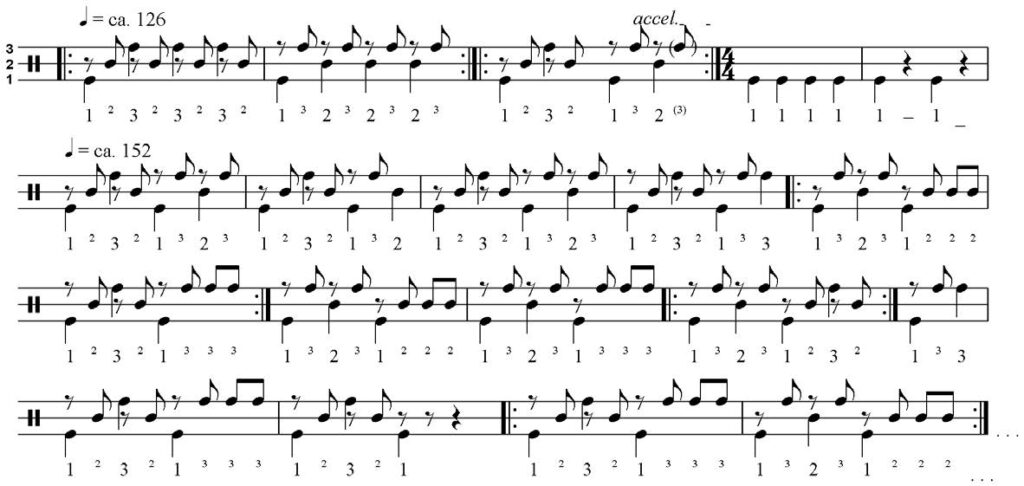
GNI DAT 375/2
Recorded: Ajdovščina, 2006
Chimers: Jože Mehle (1978), Robert Mehle (1988), Tjaša Pleško (1988) from Šmarje-Sap
Younger bell chimers, who often have a formal music education, seek new opportunities for musical expression. They create new bell-chiming tunes and enrich them with various technical procedures: variation, ornamental elements, improvisation, and interpretative procedures such as dynamics, agogics, and tempo. Sedemka mix is an adaptation of a tune known elsewhere as Sedemka (The Seven) or Na sedem (On Seven). The bell chimers, who won the bell-chiming competition in Ajdovščina, occasionally emphasize the basic seven strikes, after which the tune is named.

GNI Ravanca, 15. 8. 2007, Rez.
Recorded: Prato di Resia (Italy), 2007
Chimers: Paulino Dillenarno (1952), Roberto Mocnik (1972)
Bell-chiming (known here as tintinanje) has been preserved in Resia. One chimer usually chimes two smaller bells, while the largest one rings (se težë). Bell chimers repeat the motif (a), which they occasionally change (b) or embellish (c).

GNI DAT 353/8
Recorded: Lesce, 2006
Chimers: Janez Bijol (1972), Robert Carotta (1973), Matej Justin (1972), Simon Švab (1981)
The bell chimers from Lesce play flying and stationary tunes that they have mostly created or adapted themselves. One of the stationary tunes is also Abraham ima sedem sinov (Abraham Has Seven Sons), which is melodically structured and imitates the original song. The chimers also embellish it with intermediate thickening.
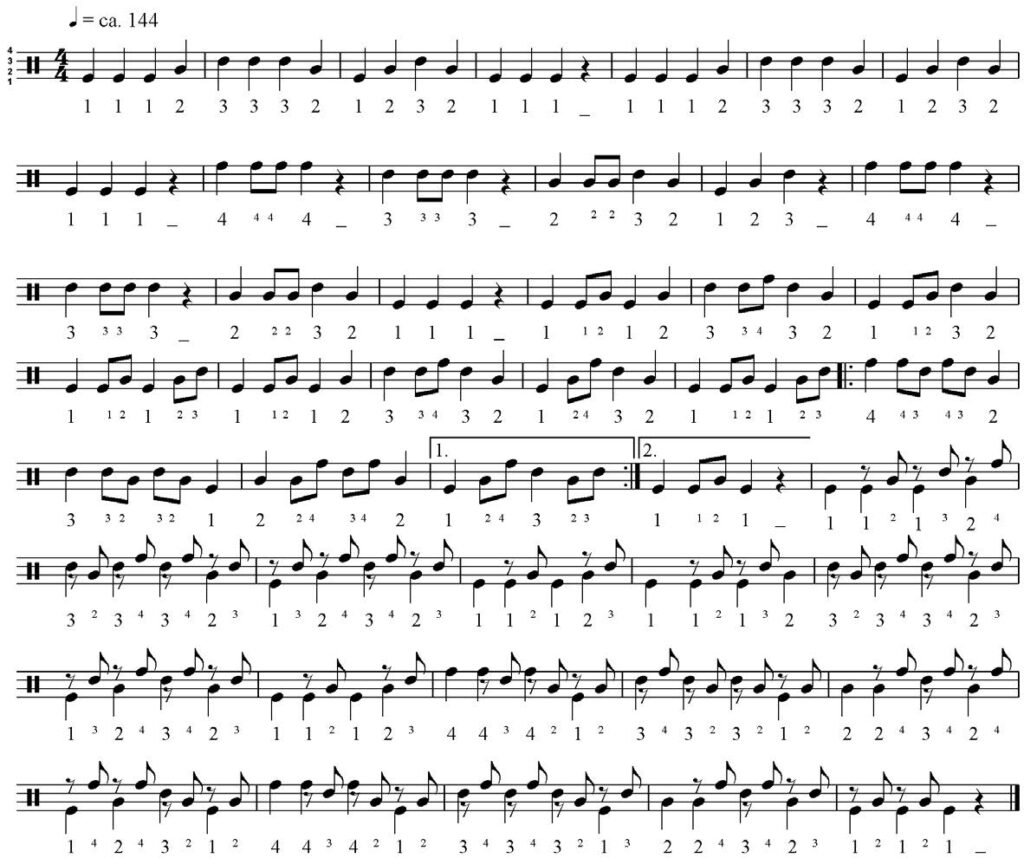
GNI DAT 351/1
Recorded: Vodice, 2005
Chimers: David Bider (1985), Grega Kimovec (1977), Blaž Koželj (1986), Janko Lužar (1968), Janez Ziherl (1978)
The patron saint of the church in Vodice is St. Margaret Antioch, and so the local bell chimers named one of their new flying tunes Marjetna (Margaret’s). Its special feature is that it is performed na dvanajst korakov (on twelve steps), which means that the theme repeats itself when the largest bell strikes twelve times.

GNI DAT 375/12
Recorded: Ajdovščina, 2006
Chimers: Jure Lužnik (1981), Klemen Novšak (1968), Nejc Perko (1986), Klemen Pernuš (1981)
Some titles of bell-chiming tunes explain the melodic structure, whereas others are named after a place, the bell chimer’s name, its melodic model, or the associations they evoke to bell chimers. Goveja is a rhythmically and metrically complex tune with a freer formal structure.
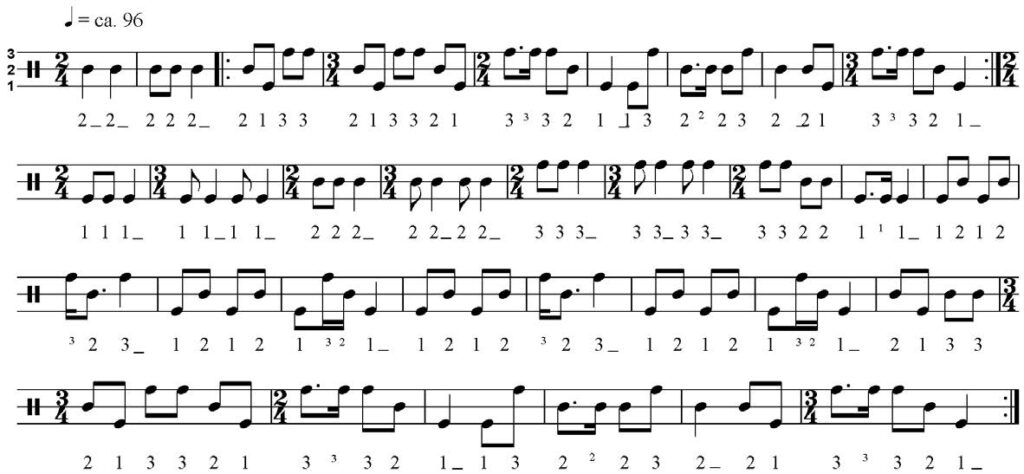
GNI DAT 369/4
Recorded: Slap pri Vipavi, 2006
Chimers: Martin Gregorc (1982), Jernej Ferjančič (1982), Peter Medvešček (1981)
The bell chimers in the Vipava Valley often borrow aesthetic criteria and repertoire from a book by their compatriot, the campanologist and bell chimer Ivan Mercina. To be able to do this they must know the numerical notation of the bell-chiming tunes used by Mercina and have a lot of skill because the majority of the tunes in the book are fairly demanding in terms of performance. In this recording, the demanding element is the sequential shift from thickening to the main strikes, which the bell chimers refer to as t’dm.

GNI DAT 313/11
Recorded: Smlednik, 2005
Chimers: Jože Bonča (1945), Franc Bonča (1952), Andrej Čarman (1939), Marko Kumer (1964), Jože Rozman (1958), Joža Zupan (1949)
Catching the clapper can be performed with flying tunes, in which one of the chimers catches the clapper of a swinging bell with a rope. While he prevents the clapper from striking against the rim of the bell, the other chimers continue to chime. In the meantime, the main strikes of the swinging bell are taken over by another bell.

GNI Vuhred, 12. 5. 2007, Kor./T38
Recorded: Vuhred, 2007
Chimer: Peter Vidmar (1935) from Brdo pri Lukovici
The chimer was encouraged to play independently in his childhood by the local sexton, who emphasized that the basic point of bell chiming is the ability to play the entire tune alone. The chimer performs the tune Na sedem (On Seven) in a circle, which means that all of the bells take turns performing the basic motif of seven strikes. The tune is played as a canon because a new seven-strike motif begins before the first ends.

GNI Zasavska sveta gora, 8. 6. 2008, Štaj.
Recorded: Holy Mount in the Central Sava Valley, 2008
Chimers: Andrej Mikelj (1993), Jernej Puš (1992), Bine Rovanšek (1992), Timotej Zaletel (1992) from Šentvid pri Stični
Bell-chiming competitions are attended primarily by young bell chimers because this is an opportunity for them to have their bell-chiming efforts evaluated. The musical and well-coordinated group bell ringing by the group from Šentvid pri Stični won first place at the competition at Holy Mount in the Central Sava Valley in 2008.
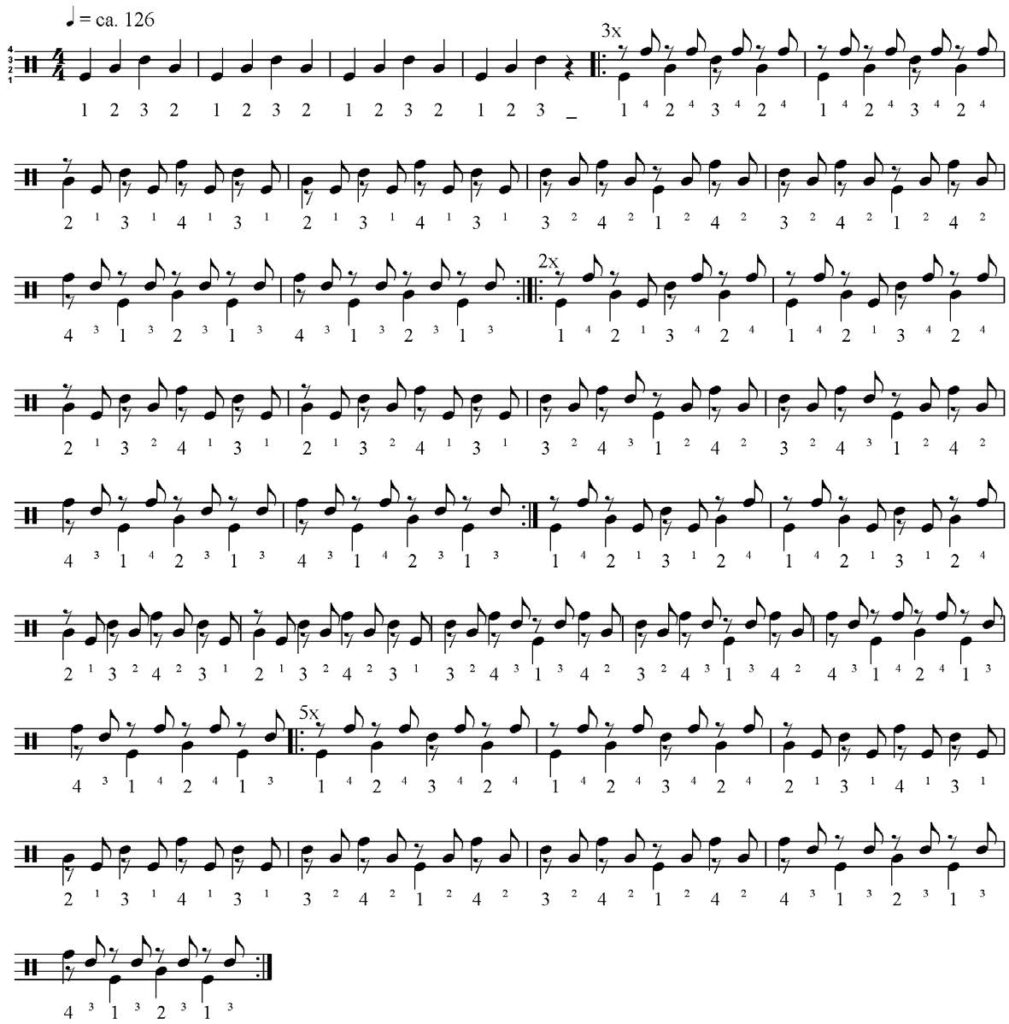
GNI Destrnik 25. 12. 2007, Štaj./10
Recorded: Destrnik, 2007
Chimers: Mitja Vindiš (1980), Uroš Zelenik (1979), Miran Zorko (1977)
It is custom in Destrnik to perform bell-chiming (known here as trjančenje) before the church service and during specific parts of the service such as the gospel, offertory, elevation, and blessing. They keep a speaker in the corner of the bell tower so that they can follow the service. They play an additional tune (known as a štuk) with each part of the service. In the end they play a series of five tunes, which they name after the number of main and response strikes in a motif.

GNI DAT 313/19
Recorded: Smlednik, 2005
Chimers: Joža Zupan (1949), Franc Bonča (1952), Jože Bonča (1945), Marko Kumer (1964)
This tune with five main strikes in its basic theme is the most frequently performed tune in Slovenia. It is referred to by various names: U pet, Na pet, Petica, Finfar, Petka, Po pet, and V pet žvakov (all referring to number five). The Smlednik version U pet is performed on four bells. On the third and fourth bells, the theme played by the first two bells is repeated as a thickening canon.

GNI DAT 372/12
Recorded: Dolsko, 2006
Chimers: Janez Bijec (1954), Andraž Čebular (1988) from Šentvid pri Stični
The tune Šmarčan is performed by two chimers using four bells. The tune is thick, which means the strikes are performed in a fast tempo and it is therefore difficult to perform on bells that are considerably far away from one another or have heavy clappers. Every chimer decides on his own which rhythmic forms to play. The bell chimers often also perform the rhythmic form 𝅘𝅥𝅮𝅘𝅥𝅯𝅘𝅥𝅯, known as the konjski topot (horse stamp).

GNI DAT 336/23
Recorded: Višnja gora, 2005
Chimers: Miha Kogovšek (1980) Rado Kogovšek (1952), Lovrenc Treven (1985) from Vrh Sv. Treh Kraljev
The tune Potresavka is named after the polka, also known as ta potresana, ceprle, or dobljanec. It is characterized by improvised ornamental strikes on the third bell.

GNI Vrzdenec, 6. 6. 2007, Not./4
Recorded: Vrzdenec, 2007
Chimers: France Jereb (1937), Danijel Celarec (1981), Evgen Simonišek (1978)
Mejavka is a tune referred to as na zvon (on the bell), as the Vrzdenec chimers call the flying tunes. It received its name from the mejavanje (alternation) of roles between the second and third bell. Thickening strikes are gradually added to the tune, and in some places they are the same as response strikes, which thicken the tune. In some places they say that the chimer “thickens behind himself” (za sabo pogosti).
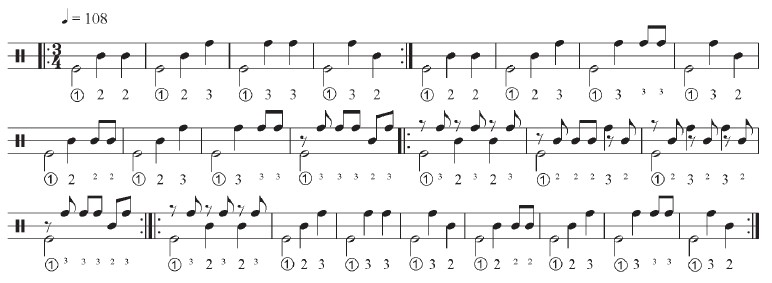
Mojca Kovačič: Bell Chiming
Bell chiming is a folk instrumental musical practice characterized by rhythmic strikes against the rims of church bells. It is “a special festive method of rhythmic bell ringing” (Kumer, 2004: 477) whose sound symbolizes joy, festivity, and celebration. In addition to church holidays, bell chiming is also used to mark some secular holidays such as Statehood Day, New Year, municipal holidays, and so on. It is usually performed one day before the holiday—at 4 pm in the summer and at 3 pm in the winter—in order to announce the upcoming holiday. On the holiday itself, bell chiming is usually performed before and after the church service. In some places it is also used for first communions, confirmations, and weddings (most often for the fiftieth wedding anniversary and bell chimers’ weddings), and often also to mark bell chimers’ death. Bell chimers are important members of the church and village community. Not long ago it was typical for “boys and men to perform bell chiming” (Strajnar, 1985: iv), but today increasingly more girls and children are becoming involved in bell chiming. They can do so both because of changes in the social norms and promotion of equal inclusion of women and children in social and cultural life, as well as for practical reasons; today lighter clappers are often used with bells or bell chiming is made easier because the clappers’ weight is borne by levers.
Bell chiming is part of the Slovenian and broader European musical tradition because similar bell-chiming techniques are also practiced in parts of Belgium, Croatia, France, Italy, Germany, the Netherlands, Spain, Sweden, Switzerland, and probably elsewhere as well (see Kovačič, 2009: 287–307). However, records indicate that nowhere is this activity organized to such an extent as in Slovenia. Here, bell chimers form music associations, they meet at roundtables, bell-chiming gatherings, and competitions, and they teach bell chiming in courses and summer schools.
Despite its new functions, bell chiming remains an important part of church music, but at the same time, from the perspective of musical content and transfer of tradition, it is also part of Slovenian folk music. Even though bell chimers still tend to learn tunes by ear, various notation systems are proving to be an increasingly important and integrated form of musical transfer for bell chiming. During the past century, bell chimers developed various forms of notation systems based on generally understood musical language and developed from the acoustic and technical characteristics of the instrument and activity. Bell chimers have thus used alphabetical notation, geometric shapes, syllabic or word-based notation, adapted western musical notation, colors, and numerical notation. Because the numerical system is the most common among bell chimers, it is also included in the musical notation accompanying this sound publication.
The actual sound of bell-chiming tunes varies from place to place, but certain common characteristics can nonetheless be identified. Musical performance is usually based on the synchronized playing of individuals in a group, in which every individual chimes the church bell using his own rhythmic form, thus contributing to the rhythmic-melodic whole of the bell-chiming tune. With regard to the role of individual tones, bell-chiming tunes can be divided into two basic groups:
1. Strikes are divided into main and response strikes: Main strikes (also known as takti, žvaki, žlaki, and štihi) are usually performed on the largest bell in the main motif (they are marked as 1 or 𝅘𝅥 in the notation), and their number can often be established from the name of the tune (see Example 1); response strikes (odbijanje; also known as obiranje, odbivanje, prikladanje, and prilaganje) are strikes that “respond” to the main strikes and form the basic motif together with them (they are marked as 2 or 𝅘𝅥 in the notation), and they are most often performed using the middle bell; thickening strikes (gostenje; also known as drobljenje, glestenje, ubiranje, presekavanje, and mlatenje) refer to the strikes that fill in the gap between the main and response strikes, and are most often performed in a syncopated rhythm on the smallest bell (marked as ³ or 𝅘𝅥𝅮 in the notation).
Example 1: Na tri žlake (On Three Strikes; Vrzdenec, 6. 6. 2007, Notr.)

The number of lines on the staff corresponds to the number of bells, and the number in front of the staff marks the bell’s size, from the largest (1) to the smallest (2, 3, 4, or 5).
2. Strikes have equal roles: Bell-chiming patterns usually approximate existing tunes by using the same rhythm and similar relative intervals (Example 2) or are independent compositions.
Example 2: Mojster Jaka (Frère Jacques; Višnja Gora, 4. 9. 2005, Dol.; Vrh Sv. Treh Kraljev)

Bell chimers transform the basic rhythmic forms in various ways: they change the roles of individual bells, embellish the motifs by rapidly repeating the strikes, catch the clapper, and so on. Today’s methods of musical performance include increasingly more agogic and dynamic changes. Younger bell chimers are also more active as composers and some of them have even published their own works (e.g., Mehle, 2003). In some cases they publish and adapt bell-chiming tunes that are already well known, and in other cases the tunes are completely new and also represent something new in the creative sense, with compositions usually having more complex forms.
In terms of the bell position and from the technical viewpoint, there is a distinction between chiming flying tunes (when one of the bells is swung and the others are stationary) and stationary tunes (when all the bells are stationary), but the majority of bell chimers perform both types of tunes. In terms of how the sound is produced, a distinction is made between direct or manual bell playing (in which the bell chimer holds the clapper and strikes it against the rim of the bell), playing with levers (in which ropes or chains are run from the clapper to a fixed point in the bell tower), and playing with (wooden or iron) hammers. The last technique most likely resulted from the confiscation of bells during wartime, which forced bell chimers to play a smaller number of bells or even objects that substituted for the sound of the bells. By striking the hammer against various places on an individual bell they thus produced several different tones. Even though this tradition is interesting, it is controversial from a campanological perspective (cf. Mercina, 1926: 15–17) because it causes many bells, which have not only material value but also historical value, to crack.
With respect to the relation between the performers and the number of bells, four methods of performing are distinguished: one chimer performing alone on all bells; each chimer performing on two bells; one chimer performing on two bells, and the others each on their own bell; and each chimer performing on his own bell. This kind of relation often influences the method of forming a tune because in cases when a chimer handles several bells by himself the performance is usually freer in terms of form, with frequent improvisation.
In 1985, the first bell-chiming audio recording was released. It enjoyed an enthusiastic response among bell chimers and the general public, and was soon sold out (despite its later reissue on a CD). The Institute of Ethnomusicology decided to release a new sound publication rather than reissue the old one because the latest field research has contributed new findings on bell chiming; moreover, new audio examples have added to the presentation of the diversity and wealth of this practice in Slovenia. With the audio recordings selected here, we seek to present various musical and technical methods of performing on bells, and each audio example is accompanied by a short ethnomusicological commentary. Field experience has shown that many bell chimers also learned new tunes using the notations of bell-chiming tunes that were included with the previously mentioned audio recording. Therefore, this sound publication also includes musical and numerical notation of bell-chiming tunes along with commentary on individual recordings. With longer tunes or where improvisation is evident, only the beginning or the most characteristic part of an individual tune is transcribed. The names of the bell chimers and the place of recording are given for individual recordings; when recording took place at bell-chiming gatherings or competitions, the place of recording is not the same as the place where the bell chimers came from. Attention should also be drawn to the fact that some recordings are technically imperfect because (usually due to lack of space) it was often impossible to set up microphones properly. As a result, some bells are louder than would be desired, and others have a weaker sound.



